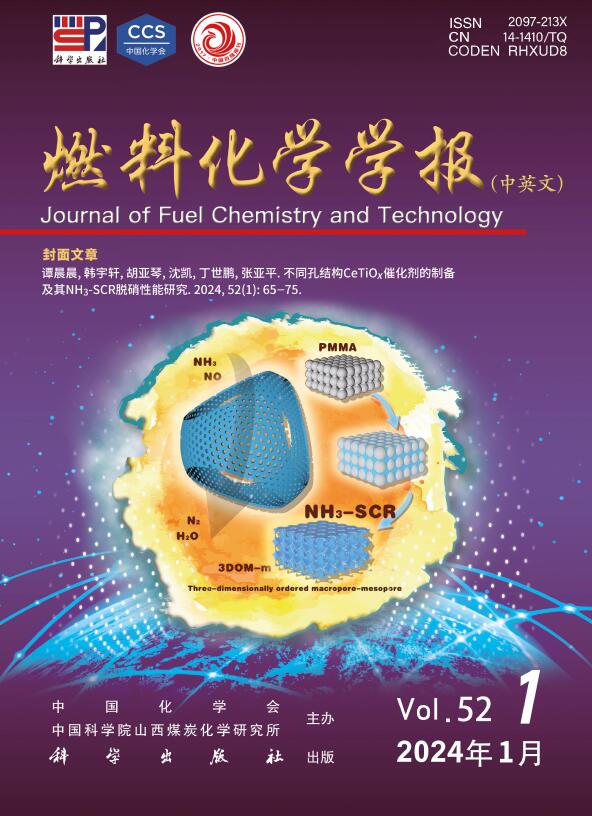Research progress in catalytic conversion of lignin to produce liquid fuels
Q3 Energy
引用次数: 0
Abstract
Lignin is recognized as the most abundant renewable aromatic polymer in nature with the highest concentration of benzene ring structures, and it stands out for its eco-friendly, sustainable, and biodegradable properties. The valorization of lignin through biorefinery strategies to produce aromatic compounds, which are subsequently converted into tailored lignin-derived liquid fuels via catalytic hydrogenation, deoxygenation, and other upgrading processes, has become a central focus in comprehensive biomass utilization research. This article systematically reviews the fundamental aspects and technological advancements in lignin-to-fuel conversion. Initially, it elaborates on the basic structural units of lignin—primarily the three phenylpropane monomers (guaiacyl, syringyl, and p-hydroxyphenyl units)—and their diverse interunit linkages, including β-O-4, α-O-4, 4-O-5, β-β, β-5, and 5-5 bonds, which collectively contribute to lignin's structural complexity and recalcitrance. These linkages dictate the depolymerization challenges and influence the selection of conversion pathways. Subsequently, it comprehensively reviews the principal technical pathways for manufacturing bio-based liquid fuels from lignin, particularly detailing three strategic approaches for producing liquid-phase products: lignin gasification-Fischer-Tropsch synthesis by gasifying lignin into syngas (CO/H2) and then catalytically reassembling into liquid hydrocarbons, lignin pyrolysis liquefaction involving thermal decomposition at 400–800 °C under inert conditions to yield bio-oil, and lignin liquid-phase catalytic conversion by employing solvents and catalysts to depolymerize lignin into monomers under milder conditions. Special emphasis is placed on analyzing key technologies in fuel production, including catalytic hydrodeoxygenation (HDO) and carbon-carbon coupling reactions. The discussion critically evaluates current technological limitations and challenges in lignin-to-fuel conversion, highlighting two pivotal technical bottlenecks requiring urgent resolution: the design and optimization of more stable and efficient catalytic systems, and the improvement of separation/purification processes for lignin depolymerization products. Furthermore, building upon contemporary research trends in bio-liquid fuels, the paper proposes that future investigations should prioritize the development of high-carbon-number cyclic aviation biofuels and high-density biodiesel derived from lignin. These directions are particularly promising given lignin's unique aromatic structure and high energy density characteristics, which align well with the stringent performance requirements of advanced transportation fuels. The analysis underscores the necessity for interdisciplinary collaboration between catalysis science, process engineering, and materials chemistry to overcome existing barriers. Specifically, the development of multifunctional catalysts capable of simultaneously activating multiple reaction pathways while resisting deactivation under harsh processing conditions represents a critical research frontier. Additionally, the integration of novel separation technologies such as membrane filtration and ionic liquid extraction with traditional distillation methods may revolutionize the purification of complex lignin-derived mixtures. From an industrial application perspective, the paper emphasizes the importance of establishing techno-economic models and lifecycle assessments to evaluate the commercial viability and environmental benefits of various lignin conversion routes. The potential synergies between lignin valorization and existing petroleum refining infrastructures are also discussed as a strategic approach to accelerate technology deployment. In conclusion, while significant progress has been made in understanding lignin's conversion mechanisms, the transition from laboratory-scale achievements to industrial implementation demands sustained efforts in catalyst innovation, process intensification, and system integration. The realization of economically competitive lignin-derived liquid fuels could fundamentally transform the renewable energy landscape by providing sustainable alternatives to fossil-based transportation fuels while fully utilizing lignocellulosic biomass resources.
木质素催化转化制液体燃料的研究进展
木质素是自然界中含量最多、苯环结构含量最高的可再生芳香族聚合物,具有环保、可持续、可生物降解等特点。通过生物精炼策略使木质素增值以生产芳香族化合物,这些化合物随后通过催化加氢、脱氧和其他升级过程转化为定制的木质素衍生液体燃料,已成为生物质综合利用研究的中心焦点。本文系统地综述了木质素转化为燃料的基本方面和技术进展。首先,它详细阐述了木质素的基本结构单元-主要是三个苯丙烷单体(愈创木酰基、丁香基和对羟基苯基)-以及它们不同的单元间键,包括β- o -4、α-O-4、4-O-5、β-β、β-5和5-5键,这些键共同促进了木质素的结构复杂性和顽固性。这些联系决定了解聚的挑战并影响了转化途径的选择。随后,它全面回顾了从木质素生产生物基液体燃料的主要技术途径,特别是详细介绍了生产液相产品的三种战略方法:木质素气化-费托合成:木质素气化成合成气(CO/H2),然后催化重组成液态烃;木质素热解液化:在惰性条件下400-800℃热分解,生成生物油;木质素液相催化转化:在温和条件下,溶剂和催化剂将木质素解聚成单体。特别强调分析燃料生产中的关键技术,包括催化加氢脱氧(HDO)和碳-碳偶联反应。讨论批判性地评估了当前木质素到燃料转化的技术限制和挑战,强调了两个迫切需要解决的关键技术瓶颈:设计和优化更稳定和高效的催化系统,以及改进木质素解聚产物的分离/纯化过程。此外,基于当前生物液体燃料的研究趋势,本文提出未来的研究应优先发展高碳数循环航空生物燃料和木质素衍生的高密度生物柴油。鉴于木质素独特的芳香结构和高能量密度特性,这些方向特别有前景,这与先进运输燃料的严格性能要求非常一致。分析强调了催化科学、工艺工程和材料化学之间跨学科合作的必要性,以克服现有的障碍。具体来说,开发能够同时激活多种反应途径,同时在恶劣加工条件下抵抗失活的多功能催化剂是一个关键的研究前沿。此外,膜过滤和离子液体萃取等新型分离技术与传统蒸馏方法的结合可能会彻底改变复杂木质素衍生混合物的纯化。从工业应用的角度出发,本文强调了建立技术经济模型和生命周期评估的重要性,以评估各种木质素转化途径的商业可行性和环境效益。还讨论了木质素增值与现有石油精炼基础设施之间的潜在协同作用,作为加速技术部署的战略途径。总之,虽然在了解木质素转化机制方面取得了重大进展,但从实验室规模的成果到工业实施的转变需要在催化剂创新、工艺强化和系统集成方面持续努力。实现具有经济竞争力的木质素衍生液体燃料可以从根本上改变可再生能源格局,为化石运输燃料提供可持续的替代品,同时充分利用木质纤维素生物质资源。
本文章由计算机程序翻译,如有差异,请以英文原文为准。
求助全文
约1分钟内获得全文
求助全文
来源期刊

燃料化学学报
Chemical Engineering-Chemical Engineering (all)
CiteScore
2.80
自引率
0.00%
发文量
5825
期刊介绍:
Journal of Fuel Chemistry and Technology (Ranliao Huaxue Xuebao) is a Chinese Academy of Sciences(CAS) journal started in 1956, sponsored by the Chinese Chemical Society and the Institute of Coal Chemistry, Chinese Academy of Sciences(CAS). The journal is published bimonthly by Science Press in China and widely distributed in about 20 countries. Journal of Fuel Chemistry and Technology publishes reports of both basic and applied research in the chemistry and chemical engineering of many energy sources, including that involved in the nature, processing and utilization of coal, petroleum, oil shale, natural gas, biomass and synfuels, as well as related subjects of increasing interest such as C1 chemistry, pollutions control and new catalytic materials. Types of publications include original research articles, short communications, research notes and reviews. Both domestic and international contributors are welcome. Manuscripts written in Chinese or English will be accepted. Additional English titles, abstracts and key words should be included in Chinese manuscripts. All manuscripts are subject to critical review by the editorial committee, which is composed of about 10 foreign and 50 Chinese experts in fuel science. Journal of Fuel Chemistry and Technology has been a source of primary research work in fuel chemistry as a Chinese core scientific periodical.
 求助内容:
求助内容: 应助结果提醒方式:
应助结果提醒方式:


